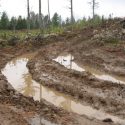Unique cooperative class gets national view of popular conservation technique
Using a national approach to studying a complex question of environmental policy, Adena Rissman, a professor of forest and wildlife ecology at the University of Wisconsin–Madison, guided a graduate seminar that examined the use of conservation easements in Wisconsin.
Under an easement, landowners can sell or donate certain rights — frequently the right to build — to obtain enduring protection for their land. But it’s difficult to find out how well easements work, says Rissman. Each easement is a contract that may have different terms, and the nonprofits and agencies that own easements may lack the time or expertise to monitor the results.
And thus Rissman — who has studied private land conservation for almost a decade — joined colleagues at institutions in California, Colorado, Indiana, New York and South Carolina to build seminar examining the situation in each state.
The UW–Madison seminar studied eight easement holders — both governmental and private — in the Northwoods, the Driftless Area and the Lake Michigan shore. Their preliminary results will be presented between 3-4:15 p.m. on Monday, June 6, in the Red Gym on the UW–Madison campus, during a session of the International Symposium on Society and Resources Management.
Rissman admits to some trepidation about the project. “The course asked students to take tackle a big challenge: How do we adapt our conservation tools to changing landscapes? They had to research the social, legal, political and ecological aspects of private land conservation. Each seminar was responsible for contacting land trusts and government organizations, analyzing conservation documents and interviewing staff from the organization.”
Easements have historically concerned less than 10 percent of the acreage of new Department of Natural Resources acquisitions. But between 2000 and 2010, easements covered about half of the approximately 260,000 acres that the agency protected.
Information on conservation through easement is dispersed in government and private hands, Rissman says. “To study easements, we have to understand all these local places and organizations, but real-estate documents are time-consuming to gather, read and understand.”
During the project, students worked on four different online surveys and uploaded documents on a wiki site that worked much like the online encyclopedia Wikipedia.
The class offered the kind of real-world challenges and experiences that seldom face college students. “Previously, I had not been in a research-based course at UW, where students conduct real research to answer an important question,” says Jessica Price, a graduate student in environment and resources. “It was both challenging and rewarding to learn new methods as well as gather and analyze results all in a single semester. I would definitely recommend this course to others interested in learning these methods and about conservation of changing landscapes.”
“It was great to learn social science methods firsthand as a researcher,” says Christina Locke, a graduate student in forest and wildlife ecology. “It was more effective than the typical lecture, book-learning and classroom-exercise way of learning research methods. When problems arose during data collection and analysis, everyone collectively gained problem-solving skills.”
Overall, the seminar was “a great way to collect dispersed information from local organizations all over the country,” says Rissman. “We were also able to bring in lots of skill sets and disciplinary backgrounds. My seminar hosted an ‘ask a law professor day’ where we called a law professor from another seminar. I also visited one of the law seminars in person to talk about environmental management.”
In addition to profiling a conservation system that is inherently variable, the seminar is intended to help conservation organizations confront the biological and physical effects of a changing climate. “There is quite a bit of variability among conservation easements,” Rissman adds. “Each easement is individually tailored from the beginning, and keeping track of them poses a big challenge, especially since the easement rights have different meanings in different places, and at the same time, the climate is changing as well.”



